Canale L.C.F., Mesquita R.A., Totten G.E. Failure Analysis of Heat Treated Steel Components
Подождите немного. Документ загружается.


been reached (d
0
B
= 0), and this is reflected on
only a partial depth of the overheated layer, d
00
B
.
Despite surface quenching, volume changes in
the surface layer are not affected, which means
that there is no distortion of the workpiece, so the
size of bending is f = 0. Bending distortion
may be noted quite rarely, and only if very in-
tensive cooling is applied with temperature dif-
ferences between the surface and subsurface
defined by the depth at which the temperature
in the specimen is equal to the temperature of
the environment. However, such cases can be
neglected, since the goal is to achieve the aus-
tenitization and homogenization temperature,
which is much higher than the temperature of the
ferrite/pearlite-to-austenite transformation, T
A
3
.
In practice, the cooling rate is adapted to the
quenching medium, which ensures the forma-
tion of a hardened microstructure with minimum
internal stresses.
Figure 67(c) illustrates conditions after
induction surface hardening achieves a very
small depth of the hardened layer, d
0
C
, and a
correspondingly small depth of the heat-affected
zone. The achieved depth of penetration (con-
duction) of heat after induction hardening is
equal to d
0
C
+d
00
C
=d
C
. The volume changes in
the specimen are influenced only by the hard-
ened layer, that is, the volume of the hardened
layer versus the entire volume of the specimen.
If the volume changes are small, then the
bending of the specimen is negligibly small. For
a given hardened layer depth, it is possible at
each point during the cooling process to ensure a
higher yield point of the material (R
p, 0:2
) than
the internal stress in the axial direction of the
specimen. When the depth of the hardened layer
is equal to or smaller than one-twentieth of the
specimen height, d
C
0
4
1
/
20
h, there is no bend-
ing deformation of the specimen, only a slight
increase in residual stresses in the axial direc-
tion, despite a minimum volume change of the
hardened surface layer.
Figure 67(d) illustrates the conditions after
induction surface hardening of a specimen with a
slightly greater depth of the hardened layer, d
C
0
,
than on the specimen in Fig. 67(b), d
C
4d
B
. The
achieved depth of penetration (heat conduction)
after induction heating is also slightly greater
and is d
C
or d
C
4d
B
. If the achieved hardened-
layer thickness is d
C
4
1
/
10
h, then hardening is
accompanied by deformation of the specimen,
described as bending deformation in the middle
of the specimen ( f40). Surface hardening
is followed first by annealing to remove the
stresses and then by mechanical straightening
and finally grinding. The procedures of sub-
sequent treatment of machine components are
chosen mainly with respect to the size of the
bending deformation.
Figure 67(e) shows the conditions after
induction surface hardening of the specimen
on both sides. Several different procedures can
be chosen to ensure two-sided hardening. The
first procedure involves hardening of the top
surface to a certain depth, d
0
E
, and then of
the bottom surface to the same depth. In the
second procedure, both top and bottom surface
are hardened at the same time. The third proce-
dure involves hardening of the top surface
from the left to the right side and the bottom
surface from the right to the left. The most sui-
table procedure is the second one, where the
top and bottom surfaces are hardened simulta-
neously to the same depth. The achieved depth
of heating is equal to d
00
E
, whereas the depth of
the hardened layer is equal to d
0
E
. When equal
heat treatment conditions are ensured on both
sides of the specimen, the depth of the hardened
layer on the top surface, d
EU
, is equal to the
depth of the hardened surface on the bottom
surface, d
ED
.
This induction surface-hardening procedure
ensures that the bending deformation in the
middle of the specimen is equal to zero ( f = 0).
Figure 68 shows two crankshafts that differ in
the position of the crankpin with respect to the
main journal. The first example presents a
crankshaft where the distance, a, between the
axes of the crankpin and the main journal is
greater than the sum of the radii of both the
crankpin and the journal:
a4
d
GL
2
+
d
KL
2
In the second example, the crankshaft is
slightly different, having the distance between
the two axes equal to the sum of the radii of the
crankpin and journal:
a=
d
GL
2
+
d
KL
2
This must be considered in the analysis of the
deformation of the crankshaft after hardening
cylindrical parts that alternate in following one
another (crankpin and main journal).
For the conditions after induction surface
hardening of the crankshaft described in the first
468 / Failure Analysis of Heat Treated Steel Components
Name ///sr-nova/Dclabs_wip/Failure_Analysis/5113_417-501.pdf/Chap_13/ 18/8/2008 4:02PM Plate # 0 pg 468
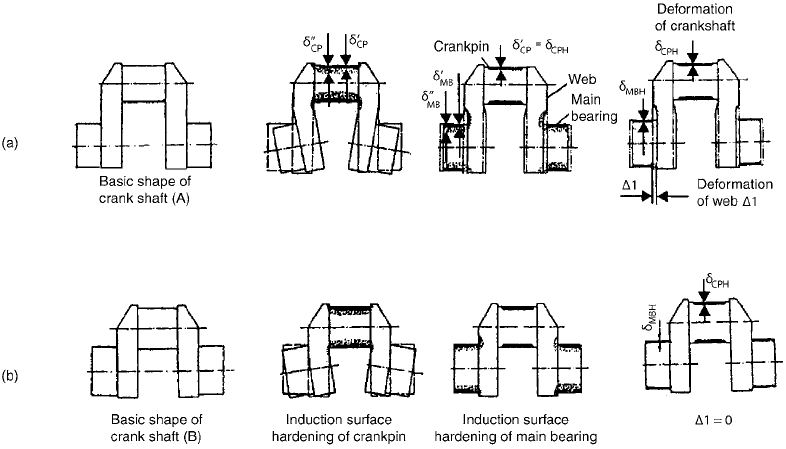
example, Fig. 68(a) shows induction surface
hardening of the crankpin, which causes the
deformation of the main journal (Ref 15). Then
follows induction surface hardening of both
main journals on the left and right side. Due to
tensile residual stresses in the web between both
main journals, the web sections come closer to
one another, and the length of this crankshaft
section shortens by 2Dl. Considering the number
of crankpins or the number of main journals, the
entire length of the crankshaft decreases by Dl.
This value depends on the number of the main
journals, N, and the size of contraction per one
embedment (Dl). The entire contraction of the
crankshaft is thus DL
C
= NDl.
In the second example (Fig. 68b), the crank-
shaft is designed differently, with the axial dis-
tance between the crankpin and the main journal
being equal to the sum of both radii (Ref 15). As
in the previous case, induction surface hardening
of the crankpin induces tensile stresses in the
web, causing distortion of the main journal. Both
adjacent main journals come closer to one
another, but the distortion is smaller than in the
first case. After induction surface hardening of
both adjacent main journals, any temporary
distortion that may have occurred vanishes, and
the crankshaft has equal length, just as prior to
heat treatment. Research has confirmed that the
stress state in the workpiece is more favorable
and distortions are smaller in progressive hard-
ening than in single-shot hardening. The only
problem is whether the size and shape of the
workpiece allow the application of progressive
hardening.
Fujio et al. (Ref 52), in their third report on
induction hardening, focused on studies of dis-
tortion of gear-wheel teeth and residual stresses
in gear wheels. The authors measured the outer
diameter and the root diameter of the gear wheel
across two opposite teeth and the root parts of
the teeth with a micrometer before and after
quenching. The same dimensions were also
calculated theoretically, taking into account the
volume changes due to phase transformations,
and serve as a basis for determination for
deviations.
Figure 69 shows a change of the outer dia-
meter of the gear-wheel tooth for gear wheels 2,
3, and 4 (Ref 20, 52). The gear wheel has 26
teeth, which means that the deviation was mea-
sured between the first and twenty-sixth tooth,
the third and sixteenth, and so on, so that thirteen
measurements were made in total. The results of
the measurements are shown as points in the
diagram. The dotted line represents the theore-
tically calculated increase in diameter due to
heat treatment.
Figure 70 shows a change of tooth height for
gear wheels 2, 3, and 4, as in the previous
Fig. 68 Crankshaft distortion after surface induction hardening of individual journal locations. Source: Ref 15
Induction Hardening / 469
Name ///sr-nova/Dclabs_wip/Failure_Analysis/5113_417-501.pdf/Chap_13/ 18/8/2008 4:02PM Plate # 0 pg 469
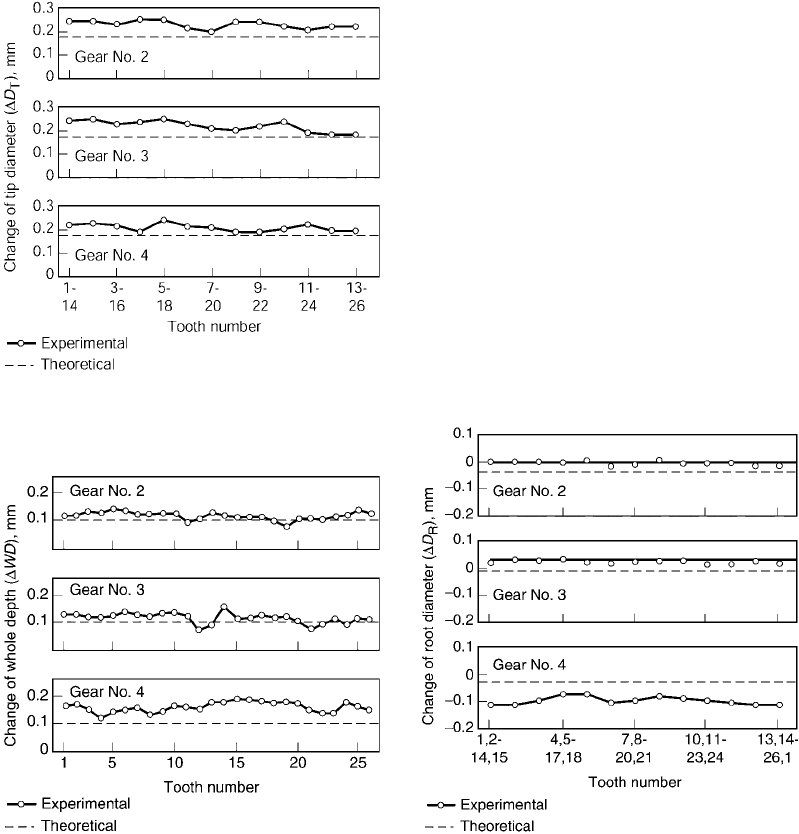
example (Ref 20, 52). The dotted lines in the
individual diagrams represent the theoretical
deviations of height of the individual teeth by
0.18 mm and the deviations found by measure-
ment, which are mainly greater than the theo-
retical values. The greatest deviation can be
found with gear wheel 4. It exceeds 0.2 mm.
Figure 71 shows changes of the root diameter.
Calculations show that after heat treatment,
the root diameter decreases by approximately
0.02 mm (Ref 20, 52). The measured values
of the same diameter, however, remained
unchanged for gear wheels 2 and 3 and de-
creased by 0.1 mm maximum for gear wheel 4.
A comparison of the outer tooth diameter and
the tooth root diameter, also taking into account
the tooth height, shows that distortion of indi-
vidual gear wheels is considerably more com-
plicated and cannot be described by the selected
measurement methods; therefore, changes of
tooth profiles along with tooth height were
measured. Figure 72 shows tooth profile error
curves after induction surface heating and after
quenching (Ref 20, 52). Prior to quenching, the
left tooth surface was marked with the letter “a”
and the right tooth surface with the letter “b.”
Measurements of the height profile are shown
for two teeth, those marked 1 and 14, of gear
wheels 2 and 3. Considering that the tooth height
is 10 mm and the deviations are plotted in milli-
meters, their absolute value can be evaluated. It
ranges between 9 and 100 mm at each tooth
surface concerned.
One method of induction surface hardening
appropriate for large gear modules is known as
gap-by-gap hardening. It belongs to the pro-
gressive hardening methods. In this case, the
coil is placed so that it ensures a uniform gap
between the coil and the flanks of two adjacent
teeth. The tooth gap-hardening method is very
demanding and requires much experience and
knowledge to achieve the desirable properties of
the gear. This method is also known as contour
Fig. 70
Change of whole depth of gear wheel after quench-
ing. Source: Ref 20, 52
Fig. 71
Change of root gear-wheel meter after quenching.
Source: Ref 20, 52
Fig. 69
Change of tip gear-wheel diameter after quenching.
Source: Ref 20, 52
470 / Failure Analysis of Heat Treated Steel Components
Name ///sr-nova/Dclabs_wip/Failure_Analysis/5113_417-501.pdf/Chap_13/ 18/8/2008 4:02PM Plate # 0 pg 470
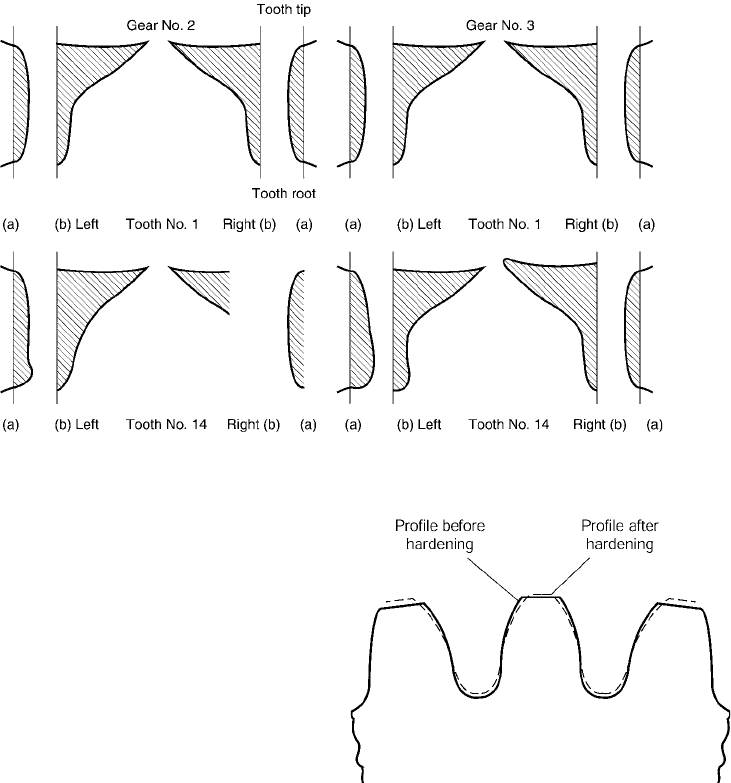
hardening. It is an ideal method for heat treat-
ment of gears because it increases the hardness
on the tooth surface only slightly and decreases
the load-bearing capacity in the tooth root. Gears
heat treated in this way exhibit very good
behavior in operation, because compressive
residual stresses are present in the root of the
tooth. Gears with induction-hardened flanks,
given that the dimensioning is carefully carried
out, can achieve the highest fatigue strength. To
verify the results of induction surface hardening,
it is necessary to discuss certain measures for
controlling the quality of the hardened layer. For
this purpose, hardness and microhardness mea-
surements supported by microstructural analysis
are commonly used. A disadvantage of this
procedure is that, due to the method of heating
and quenching (nonuniformly overheated left
and right tooth flanks), slightly higher dimen-
sional deviations may be obtained than in
simultaneous hardening of both flanks of the
same tooth (Ref 27).
Figure 73 shows the deviation in the dimen-
sions of the tooth after induction surface hard-
ening by heating with a coil that encircles the
gear tooth (Ref 15, 20, 55).
Measurements of gear teeth and gear gaps
after induction surface hardening show an
increased volume in the tooth root and thus a
smaller gap and increased volume at the tip of
the tooth (increased gear diameter). These
volume changes result in a slightly smaller width
of the tooth above the pitch circle and slightly
increased tooth width below the pitch circle
of the gear. These dimensional deviations are
relatively small and negligible in the case of
gears with small diameter or small module, but
may become more important in gears with larger
modules and greater tooth width (Ref 55, 56).
Surface hardening of gears is one of the most
frequent applications of induction surface hard-
ening. In the first part of this chapter, different
methods of induction heating of gears was dis-
cussed, depending on gear size but also on the
properties expected of gears after heat treatment.
Fig. 72 Tooth profile error curves (a) after induction surface heating and (b) after quenching. Source: Ref 20, 52
Fig. 73
Distortion of individual tooth shape after induction
hardening caused by volume changes. Source:
Ref 15, 20, 55
Induction Hardening / 471
Name ///sr-nova/Dclabs_wip/Failure_Analysis/5113_417-501.pdf/Chap_13/ 18/8/2008 4:03PM Plate # 0 pg 471
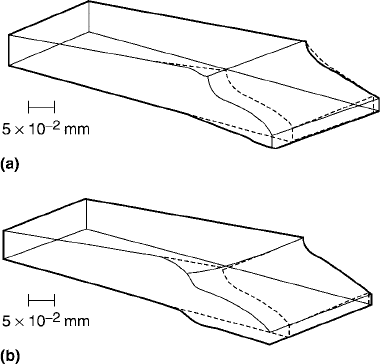
Gears are axisymmetric machine elements;
therefore, volume changes due to the trans-
formation into a martensitic microstructure in-
duced by heat treatment are to be expected.
Teeth themselves are symmetrical, which means
that careful application of uniform heating of
particular gear teeth and uniform quenching,
regardless of the method applied, should not
cause distortion after heat treatment. In induc-
tion surface hardening, compressive residual
stresses are created in the surface, which, in
addition to hardness and wear resistance of
the surface, create a considerably high fatigue
strength and resistance to bending loads.
Figure 74 shows shape distortion after single-
frequency and dual-frequency induction surface
hardening (Ref 20, 57). Figure 74(a) shows a
simulation of distortion by showing the initial
shape of the tooth half-cut prior to hardening
(dotted line) and the modified shape after dual-
frequency induction surface hardening (con-
tinuous line). Figure 74(b) shows a similar
simulation of distortion but for conventional
single-frequency induction surface hardening.
In Fig. 74, the calculated actual size of dis-
tortion is 50 mm, with an equivalent geometrical
scale of 2.0 mm. A comparison of both cases of
hardening from the viewpoint of tooth distortion
clearly shows that distortion in single-frequency
surface induction hardening is twice that
obtained after dual-frequency hardening.
This difference in tooth distortion can be
attributed to the fact that in single-frequency
surface induction hardening, the martensitic
transformation occurs in the whole tooth. Con-
sequently, the volume change of the tooth
is greater and so is the distortion. In dual-
frequency surface induction hardening, only
the tooth contour becomes hardened. Con-
sequently, the volume change of the tooth is
smaller and so is the distortion, that is, it equals
only half of that obtained after single-frequency
hardening.
Residual Stresses after Induction Surface
Hardening and Finish Grinding
The last phase in the manufacturing of
crankshafts is fine grinding, where achieving the
desirable condition of the surface and the surface
layer requires:
Suitable dimensions of the particular bearing
locations with respect to the allowable
deviations
Suitable surface roughness
Grinding stresses are compressive or the
lowest tensile to maintain the favorable
stress profile obtained by induction surface
hardening of the surface layer
Smallest changes possible in the micro-
structure and also smallest changes in the
hardness and microhardness profiles in the
heat-affected zone after grinding
How is it possible to assure a desirable surface
and surface layer quality after induction surface
hardening and fine grinding? Finding an answer
to this question requires a very good knowledge
of the process of grinding on the microlevel as
well as all mechanical and heat effects acting on
the layer of the workpiece, including the type
and condition of the grinding wheel. An all-
inclusive consideration of the numerous influ-
ences of the kind and condition of the tool on the
changes on the surface and in the surface layer of
the workpiece in the given machining conditions
can be based on the descriptions of surface
integrity (Ref 58–63).
For the grinding process, the following con-
ditions have been selected:
Different kinds of grinding
Different grinding conditions (gentle,
normal, abusive)
Because of thermomechanical loads in the
thin surface layer during the grinding process,
Fig. 74
Distortion after induction surface hardening with
(a) dual frequency and (b) single frequency. Source:
Ref 20, 57
472 / Failure Analysis of Heat Treated Steel Components
Name ///sr-nova/Dclabs_wip/Failure_Analysis/5113_417-501.pdf/Chap_13/ 18/8/2008 4:03PM Plate # 0 pg 472
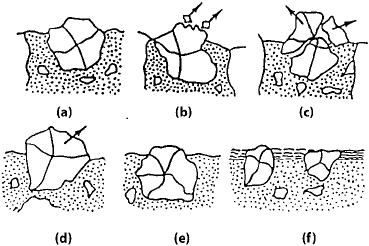
very complex physical and chemical processes
take place on the microlevel. For an accurate
description of the conditions in the contact zone
for machining a given material, it is necessary to
consider the grinding method as well as the kind
of material from which the grinding wheel is
made, its structure, and the grinding conditions.
The heat conditions in grinding are a result of the
contact conditions between the individual grind-
ing grains and the workpiece material as well as
deformation work in chip formation in the shear
zone. The amount of generated heat is strongly
dependent on the chosen machining conditions
and is abducted mainly through the chip, while a
smaller part of the generated heat is transferred
through heat transfer into the thin surface layer
of the workpiece. Heating of the chip does not
cause any particular difficulties, but heating of
the thin surface layer of the workpiece creates
the conditions for different mechanical and
thermokinetic processes, which cause micro-
chemical changes. Heating up the thin surface
layer of the workpiece can leave certain unde-
sirable effects that change the properties of the
part surface layer and thus harm its operational
abilities. The generated friction heat is trans-
ferred through the heat-transfer phenomenon
from the contact between the grinding grain and
the workpiece into the grinding grain.
The increased amount of heat on the grinding
grain or grinding wheel intensifies the wear
processes and damage of particular grinding
grains, which follow very different and complex
mechanisms and, in the final phase, affect the
serviceability and operational life of the tool.
The grinding tool consists of grinding grains,
each representing a process. Grinding grains are
interconnected with an appropriate binder,
which is defined by different degrees of porosity
of the grinding wheel structure. Therefore, it is
necessary to also know the force needed to break
the grinding grain from a given structure, ex-
pressed by the grinding wheel hardness. Simul-
taneous changes in volume proportions of the
grinding grains and binder can create different
structures on the grinding wheel that do not be-
have in the same way. This means that by
changing the kind of material for the grinding
wheel and the binder, it is possible to achieve
equal effects by changing the structure of the
grinding wheel. It follows that by a suitable
combination of influential parameters, it is pos-
sible to achieve a longer life and wear resistance
of the wheel in equal kinematic conditions of the
wheel and the workpiece. The wear of the
grinding grains is a result of mechanical and
thermal effects, which are reflected in reduced
cuttability. Figure 75 shows the basic forms of
wear and damage on the grinding wheel grains,
expressed by characteristic changes on the
grinding grains (Ref 15, 64). Due to mechanical
loads on particular grinding grains, short-lived
but intensive heat effects are created in the con-
tact or on the friction surfaces with the work-
piece. In these cases, blunting of the grinding
grains (Fig. 75a), breaking off of the grind-
ing grains (Fig. 75b), or splitting of the grinding
grains (Fig. 75c) may happen. Requirements are
often set that a worn-out grain should fall from
the grinding wheel at a certain moment. A worn-
out grain typically has an increased contact
surface, which causes the forces on the grinding
grain during the cutting process to be higher than
the binding forces between the grains, and there-
fore, the grain falls out (Fig. 75d). It is expected
that the manufacturing engineer will carefully
choose all the parameters of the process so that
the worn-down grains fall out. This ensures
more efficient machining and reduced thermo-
mechanical effects in the thin surface layer of the
workpiece material. To create a suitable quality
of the workpiece surface and surface layer, it
is necessary to ensure that grinding grains will
fall out, and that the activation of new, sharp
grinding grains is made possible.
It is very important to choose a cutting con-
dition that would make the grains fall out only
when their cuttability is reduced. Figure 75(e)
illustrates characteristic blunting of the grinding
grain due to chemical reactions at high tem-
peratures. Chemical reactions at high tempera-
tures are frequently followed by filling the pores
with overheated, highly plastic chips of the
workpiece material (Fig. 75f). When the pores
Fig. 75
Basic forms of wear and damage on the grinding
wheel grain. Source: Ref 15, 64
Induction Hardening / 473
Name ///sr-nova/Dclabs_wip/Failure_Analysis/5113_417-501.pdf/Chap_13/ 18/8/2008 4:03PM Plate # 0 pg 473
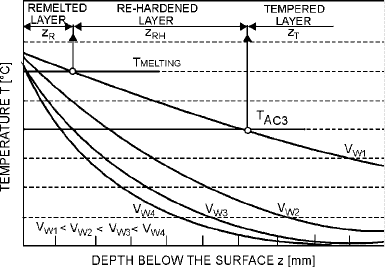
on the wheel surface become filled, the tem-
perature in the contact zone rises and changes
the progress of the temperature cycle into the
depth of the workpiece. The maximum tem-
perature of the temperature cycle on the surface
rises, as does the temperature in the particular
depths of the workpiece material. This results in
greater depth of the heat-affected zone in the
material, which may have fatal consequences in
terms of surface layer properties of the work-
piece material.
Generally, blunting of the grinding grains
makes the contact surfaces between the grains
and the workpiece larger, which creates the
conditions for increased mechanical effects in
the contact zone and higher heat input, accom-
panied by stronger heat effects, in the surface
layer of the workpiece. A plastically deformed
layer is created because of interaction between
the grinding tool and the workpiece on the place
where the chip separates from the base.
A result is hardening of the thin surface layer
of the workpiece material and occurrence of
internal stresses that may lead to failure of the
thin surface layer and/or deformation of the
workpiece, with the presence of residual stresses
at the end of machining.
Macro- and microanalysis with optical and/or
electronic microscopes shows microcracks and/
or other damage on the surface caused by an
inadequate grinding method or procedure.
Microscopic assessment of the surface state and
damage on the surface quite often points to
inadequate grinding conditions. The most fre-
quent surface damage includes hollows, mars,
torn-off areas, built-up edges of the workpiece or
the tool, and so on. It is often necessary to con-
sider the generated heat effects that cause micro-
structural and/or chemical changes accompanied
by dimensional changes. The damage on the
workpiece surface should be taken very ser-
iously, since this may give rise to very detri-
mental friction conditions during operation with
another element in the mating pair.
In the analysis of microstructural changes in a
thin surface layer of the material after finish
grinding, it is possible to evaluate the size of the
heat-affected layer. Figure 76 shows the time
variation of the maximum temperature on the
surface at the particular depths with respect to
the workpiece speed, V
W
(work speed, V
W
)(Ref
15, 65, 66). By knowing the melting temperature
and the austenitization temperature of the dis-
cussed steel, the depths of the remelted layer and
the heat-affected layer can be defined. Under
different grinding conditions, different tem-
perature cycles were obtained on the surface and
in the depth of the heat-affected layer, which has
effected microstructural changes and changes
in the microhardness and residual stresses
(Ref 64–66).
Figure 77 presents the temperature cycles on
the specimen surface as a function of depth in
the hardened steel at given grinding conditions
(Ref 15, 65). The temperature cycles can be
treated separately as a heating phase and then a
cooling phase.
The maximum temperatures achieved at the
surface and in the surface layer, respectively, are
also very important (Ref 64). A distinction can
be made between three characteristic cases of
temperature cycles:
The maximum temperatures at the surface
and in the surface layer, respectively, are
higher than the melting temperature of the
specimen material, depending on the tem-
perature cycles (Fig. 78a) (Ref 65). Such
conditions may occur due to very sharp
grinding conditions or the selection of an
inappropriate grinding wheel with regard to
the specimen material. The depth of the re-
melted layer is only a few micrometers and
makes a very fine ledeburite microstructure
containing fine cementite spread in residual
austenite. The newly formed microstructure
has a slightly lower hardness than marten-
site. The residual stresses in the thin surface
layer will be tensile, due to plastic defor-
mation of the surface layer in grinding
caused by tensile forces in the contact zone
of the specimen material. To this should be
Fig. 76
Maximum temperature drop as a function of depth in
the hardened steel during grinding with various work
speeds, V
w
. Source: Ref 15, 65, 66
474 / Failure Analysis of Heat Treated Steel Components
Name ///sr-nova/Dclabs_wip/Failure_Analysis/5113_417-501.pdf/Chap_13/ 18/8/2008 4:03PM Plate # 0 pg 474
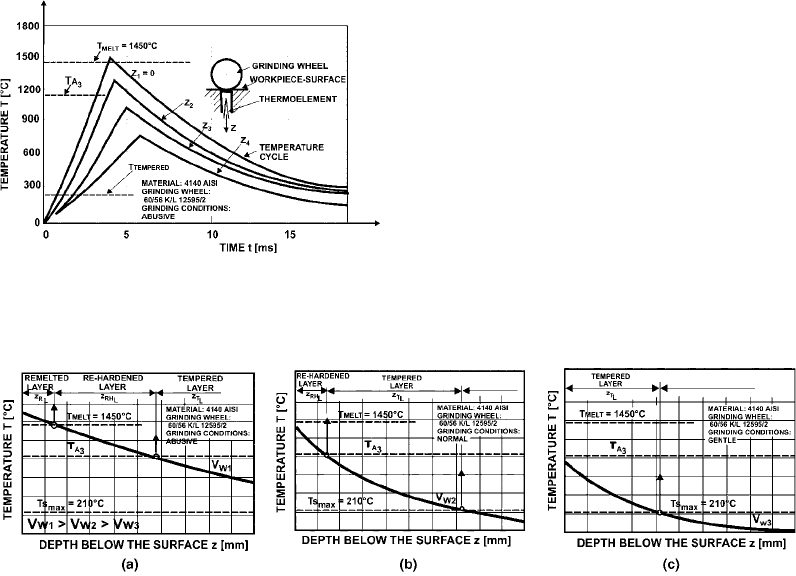
added the tensile stresses induced by the
occurrence of residual austenite.
The maximum temperature in the contact
zone is lower than the temperature required
for the beginning of melting of the given
material and higher than the austenitizing
temperature. The lower temperature, that is,
the austenitizing temperature, will shift
because of a high rate of heating of the
specimen toward higher temperatures, as
known from transformation diagrams
(Fig. 78b) (Ref 65). Provided the previous
microstructure of the surface layer was
martensite-cementite-carbide, a finer mar-
tensitic microstructure with a higher carbon
content, obtained at the expense of cemen-
tite-carbide phases and with the possibility
of a lower content of residual austenite, may
be expected in the thin surface layer after
grinding. The modified content of the
cementite-carbide phase depends on the
heating conditions, whereas the content of
the residual austenite depends on the cooling
conditions.
The maximum temperature in the contact
zone is lower than the temperature required
for the beginning of austenitization and
higher than the lower temperature that is
limited by the temperature of steel temper-
ing. It is equal to approximately 200
C
(Fig. 78c) (Ref 65). The grinding conditions
are very mild, so that with the selection of
the correct type of grinding wheel, no
important changes are expected in the sur-
face layer. Only martensitic tempering may
occur in the surface layer if it was not per-
formed during the induction surface hard-
ening of the specimen.
The engineer should be aware that surface
integrity depends on the tribological conditions
in the operation of a component/assembly.
Therefore, adequate knowledge for the assess-
ment of tribological conditions of a component
in operation is very important for the prescrip-
tion of machining that would result in the desired
surface condition and subsurface layer. In gen-
eral, there are two tribological systems. The first
is the one present during machining, and the
second is acting in operation. In both tribologi-
cal systems, however, it is the properties of the
workpiece material and its condition prior to and
after machining that play a key role. Under dif-
ferent machining conditions of grinding, differ-
ent temperature cycles were obtained on the
surface and in the depth of the heat-affected
zone, which has effected microstructural chan-
ges and changes in the microhardness and resi-
dual stresses. Thus, on the surface, a maximum
temperature higher than the temperature of
melting of the workpiece material was obtained.
The depth of the remelted layer is only a few
micrometers and makes a very fine ledeburite
microstructure containing fine cementite spread
in residual austenite. The newly formed
Fig. 78
Maximum temperature drop as a function of depth in the induction surface-hardened steel at various speed, V
w
. Source:
Ref 65
Fig. 77
Grinding temperature cycles in different depths in
the hardened steel at given grinding conditions.
Source: Ref 15, 65
Induction Hardening / 475
Name ///sr-nova/Dclabs_wip/Failure_Analysis/5113_417-501.pdf/Chap_13/ 18/8/2008 4:03PM Plate # 0 pg 475
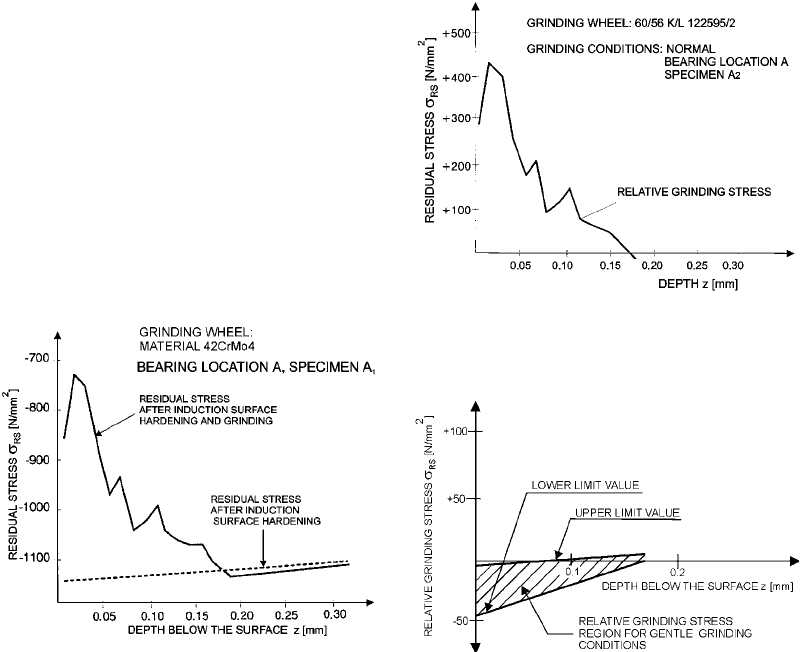
microstructure has a slightly lower hardness than
martensite. The residual stresses in the thin sur-
face layer will be tensile, due to plastic defor-
mation of the surface layer in grinding caused
by tensile forces in the contact zone of the
workpiece material as well as the tensile stresses
induced by the occurrence of residual austenite.
The relative grinding stress is obtained by
measuring the residual stress after induction
surface hardening, followed by measuring the
same spot after induction hardening and grind-
ing, then calculating their difference. Figure 79
shows the measured absolute residual-stress
profile after induction surface hardening and the
measured residual-stress profile after induction
surface hardening and grinding (Ref 15).
A relative grinding stress represents the dif-
ference between measured residual stress on
specimens that were induction surface hardened
and induction surface hardened and grinded.
A relative grinding tensile stress equals
+425 N/mm
2
, and then the sign changes in the
depth at approximately 175 mm, as shown in
Fig. 80.
Figure 80 shows the absolute residual-stress
profile after induction surface hardening and
grinding on bearing location “A” as well as the
average residual stress after induction surface
hardening. From this, the relative grinding stress
can be calculated (Ref 15).
Figure 81 shows a zone of relative grinding
stresses occurring under gentle grinding con-
ditions (Ref 54).
With gentle grinding conditions, compressive
relative grinding stresses will prevail at the
surface. It is only in the subsurface that the
tensile influence can be felt.
The relative grinding stresses are low and
practically negligible, although they exert a
positive influence on the original residual
stresses after induction hardening. The zone was
defined by the upper limiting values character-
istic of greater depths under normal grinding
conditions and by the lower limiting values
characteristic of gentle grinding conditions.
Generally, care should be taken when choosing
grinders and grinding conditions. The chosen
grinder should ensure regeneration of the abra-
sive grains, so that the worn-out grains may fall
off and the new ones grind the surface. The
selected grinding conditions should ensure that
a suitable force be applied to the worn-out
abrasive grains so that they may fall off and new,
sharp abrasive grains become active. Figure 82
Fig. 80
Subsurface profile of relative grinding stress on
bearing location “A”. Source: Ref 15
Fig. 79
Subsurface residual-stress profile after induction
surface hardening and grinding (absolute stress) on
bearing location “A”. Source: Ref 15
Fig. 81
Relative grinding stress region through thin surface
layer after gentle grinding conditions. Source: Ref 54
476 / Failure Analysis of Heat Treated Steel Components
Name ///sr-nova/Dclabs_wip/Failure_Analysis/5113_417-501.pdf/Chap_13/ 18/8/2008 4:03PM Plate # 0 pg 476
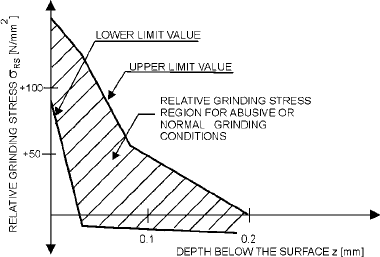
shows a zone of relative grinding stresses
occurring under abusive or normal grinding con-
ditions (Ref 54). The zone of grinding stresses
was determined from the profile of residual
stresses after induction hardening and also after
induction hardening and grinding (Ref 64).
By deducting the two residual stresses, the so-
called relative grinding stresses were deter-
mined. The abusive and normal grinding con-
ditions produce remelting of the thin surface
layer, that is, its rehardening. With the abusive
and normal grinding conditions, the tensile
relative grinding stresses are always predomi-
nant at the surface. At greater depths, there is
still the influence of remelting under the abusive
grinding conditions, whereas rehardening oc-
curs under normal grinding conditions.
For the sake of clearness, the zone was defined
by the upper limit of residual-stress values,
which is characteristic of the abusive grinding
conditions, and the lower limit, which is char-
acteristic of the normal grinding conditions
(Ref 64).
The results confirm as predominant the resi-
dual stresses, stresses induced by the plastic
deformation of the material, and as a lesser
influence, tensile stresses caused by the forma-
tion of residual austenite. On the basis of the
measurements of residual stresses after induc-
tion surface hardening or induction surface
hardening and grinding, it can be concluded:
For residual stresses after induction surface
hardening and grinding, the conditions of
abusive grinding are a more favorable
choice. They lower to a lesser extent the
desirable compressive residual stresses after
induction surface hardening.
Grinding conditions can be chosen so that
the melting temperature of the workpiece
material (gentle grinding conditions) is not
exceeded. Then, the favorable compressive
stresses after induction surface hardening
are lowered due to plastic deformation of the
workpiece material during the process, and
thus, relatively low tensile residual stresses
are obtained. However, this will signi-
ficantly lower the productivity.
Special attention should be paid to the
selection of the type of grinding wheel in
terms of grinding wheel material, binding
agent, hardness, and pore density, since a
correct selection can contribute to higher
cutting efficiency concerning the plastic de-
formation of the workpiece material. In this
way, the grinding tensile stresses are kept as
low as possible and make the compressive
residual stresses induced by induction sur-
face hardening of the prevailing variety.
Induction surface hardening creates a very
desirable residual stress state. Residual stresses
are always of a compressive nature and are
usually present to the depth of the induction
surface-hardened layer.
However, a major difficulty in induction sur-
face hardening is ensuring a very slight/slow
variation in microhardness and the existence of
compressive residual stresses in transition areas
to the microhardness of the core material. By
gently grinding and varying the hardness and
existence of compressive stresses in the transi-
tion area, it is possible to diminish the notch
effect induced by stress concentration. Addi-
tional grinding of an induction surface-hardened
surface deteriorates the stress state in the surface
layer, since grinding has always induced tensile
stresses. By the correct selection of machining
conditions and grinding wheel properties, the
engineer will contribute to less tensile residual
stresses and will avoid deteriorating the favor-
able residual-stress state after induction surface
hardening (Ref 44, 59).
Hardness Profiles in the Induction
Surface-Hardened Layer
The induction surface-hardened layer was
analyzed by measuring the hardness and
microhardness and their relation to the micro-
structure (Ref 44). To establish some relation-
ships between microstructural changes versus
Fig. 82
Relative grinding stress region through thin surface
layer after abusive or normal grinding conditions.
Source: Ref 54
Induction Hardening / 477
Name ///sr-nova/Dclabs_wip/Failure_Analysis/5113_417-501.pdf/Chap_13/ 18/8/2008 4:03PM Plate # 0 pg 477
